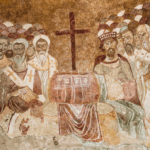This is the third post to a short series on the nature of gender. Click here to see the other posts in the series
In our last post, we had a brief look at the first appearance of gender. We saw its origin in the need of the first man for a counterpart; and in the creation of woman from man, for man.
But that’s not where gender really begins. It doesn’t begin with Adam but with another man—a man who came later but whose origins are eternal.
The Last Adam
The universe was created for Jesus. The writer of Hebrews tells us that God appointed him heir of the universe (Heb 1:2). The apostle Paul writes that all things were created for him (Col 1:16). He says that God had a secret plan—a “mystery”—to make Jesus head of everything: head of all creation (Eph 1:22 c.f. 1:10); head over every power and authority (Col 2:10); and, especially, head of his people, the church:
And he is the head of the body, the church. He is the beginning, the firstborn from the dead, that in everything he might be preeminent.
(Col 1:18).
Using this “head” image and other metaphors, Paul speaks of a special bond between Christ and his people. He depicts Jesus as the foundation stone, and us as building blocks in a temple to God (Eph 2:19-22). He uses the metaphor of a physical body where Christians are like different parts who make up Christ (Eph 4; 1Cor 12). The overall impression is that Christ is the defining principle who unites, leads and empowers a people joined to him.
To use terminology from our last post, Paul describes participation in Christ by his people: our lives come from and share in his reality.
Jesus, Sex and Marriage
Another way Paul presents this relationship is through the imagery of sex and marriage. In 1Corinthians 6:16-17 Paul compares and contrasts the spiritual bond between Christ and the believer with the physical union achieved in sex:
“…do you not know that he who is joined to a prostitute becomes one body with her? For, as it is written, “The two will become one flesh.” But he who is joined to the Lord becomes one spirit with him.” (1 Cor 6:16-17)
Similarly, in Ephesians 5:22-32, Paul tells wives and husbands to pattern their lives on Christ’s relationship to the church. That means, submission and respect on the part of the woman to her husband, and sacrificial care and provision on the part of the man.
Wives, submit to your own husbands, as to the Lord. For the husband is the head of the wife even as Christ is the head of the church, his body, and is himself its Savior. Now as the church submits to Christ, so also wives should submit in everything to their husbands. Husbands, love your wives, as Christ loved the church and gave himself up for her, that he might sanctify her, having cleansed her by the washing of water with the word, so that he might present the church to himself in splendor, without spot or wrinkle or any such thing, that she might be holy and without blemish. (Eph 5:22-27)
This is more than a metaphor. In the next three verses Paul tells husbands that caring for their wives is a kind of self-care, because the wife is a husband’s own body:
…husbands should love their wives as their own bodies. He who loves his wife loves himself. For no one ever hated his own flesh, but nourishes and cherishes it, just as Christ does the church, because we are members of his body. (vv28-30)
Next, he supports the statement with a quote from Genesis 2:24:
Therefore a man shall leave his father and mother and hold fast to his wife, and the two shall become one flesh. (v31)
And then he calls it a “mystery”:
This mystery is profound, and I am saying that it refers to Christ and the church. (v32)
Now the ESV makes it a little stronger than the original—”I am saying that it refers to” is really more like “I’m talking about”—but “this mystery” is the key. When Paul uses “mystery” he generally (and always in Ephesians/Colossians) means a secret that has been unlocked with the apostolic witness to Christ. When he uses it here, he is saying, in other words, that Jesus has revealed the true meaning of marriage. Genesis 2 was always, secretly, about Jesus. Christ’s relationship to his people is the archetype for marriage. Thomas Goodwin explains it like this:
…our Lord and Saviour Jesus Christ was the great pattern which God had set up, and man, made at first, was but as a little picture taken thereby … so take his marriage with Eve his wife, and the Apostle tells us that therein he was also but a shadow.
(Thomas Goodwin, Sermon on Ephesians 5)
Christ the True Husband
Yet what does that mean? How are these two realities alike?
The application and outworking of the comparison are relationships of submission and service—and that’s what most discussions of this passage focus on.
But the comparison itself is based on a structural reality. Wives should submit because “the husband is the head of the wife even as Christ is the head of the church” (v23).[1] Husbands must love their wives and cherish them because “he who loves his wife loves himself … his own flesh … just as Christ does the church, because we are members of his body” (v28-30).
Paul is drawing on the same understanding of gender that we saw in Genesis 2. Woman is a creature who comes from man, for man; who shares in his life and mission.
Paul is drawing on the same understanding of gender that we saw in Genesis 2. Woman is a creature who comes from man, for man; who shares in his life and mission. And the church is a creature that comes from Jesus and shares in his life and work. John Calvin explains it in terms of flesh and spirit:
… the wife was formed of the flesh and bones of her husband. Such is the union between us and Christ, who in some sort makes us partakers of his substance. “We are bone of his bone, and flesh of his flesh,” … because, by the power of his Spirit, he makes us a part of his body, so that from him we derive our life.
(Calvin, Commentary on Ephesians)
The Great Mystery
How much detail should we look for in this typology? Calvin focuses on the concept of union. Augustine sees the whole creation of Eve as an allegory:
Adam sleeps, that Eve may be formed; Christ dies, that the Church may be formed. When Adam sleeps, Eve is formed from his side; when Christ is dead, the spear pierces His side, that the mysteries may flow forth whereby the Church is formed … All was mystically prefigured.
(Augustine, Homily on John 2, Tractate 9, 10)
Perhaps that’s too much detail. And yet, reflecting on the these two relationships yields interesting parallels. For example:
- In both cases there is reunion:
In everyday marriage, woman—flesh of the man’s flesh and bone of his bone—is reunited with her origin (Gen 2:24). With Christ’s marriage, humanity—lesser image of God—is spiritually united to the eternal and true Image (Col 1:15; Phil 2:6).[2]
- In both cases there is completion:
Both Christ and Adam have a corporate self that is larger than their individual person. For Adam that corporate self is himself and the woman made from him. For Christ, that corporate self is the church: the members of his body who share in his Spirit (Eph 5:30; 1Cor 12:12); the full number of those given to Christ (John 17:6; Rom 11:25); those that fill up what is still lacking with regard to Christ’s afflictions (Col 1:24; Rev 6:11).[3]
- In both cases, there is fruit:
Just as the union between man and woman is designed to produce fruit; [4] so also the union between Christ and his people (John 15:1-5).
Conclusion
If gender and marriage are difficult for us today, it is encouraging for us to know that they are not the be-all and end-all of our existence. There is a greater and better reality beyond them. There is a better man who defines all of our existence and shows us the true meaning of “male”. There is a greater hope for all of us than finding our meaning in fleeting romance or marriage.
Ephesians 5 teaches married people how to express an echo of that higher reality through submission, love and sacrifice. But the whole of Ephesians tells us that every believer—married or single—shares in that reality directly, and was called to it from before the creation of the world.
This must change the way we think about gender. In our next post we will try to explore that a little further.
<— Previous Post … Next Post —>
Images: Alice Pike Barney [head]; Adam Kossowski, St Benet’s Cathedral [body]
[1] At this point it is customary to open the discussion on the possible meanings of kephalé (head): does it connote “authority”, “source” or “preeminence”? Is it a live or dead metaphor? Personally, I’m persuaded that the word can connote a number of things, but that the word-study is a distraction. A better place to begin is by looking at Paul’s broader conception of how Christ relates to his people. As we have seen, this involves an organic connection that involves participation and authority.
[2] So, for example, Irenaeus: “He made man the image of God; and the image of God is the Son, after whose image man was made: and for this cause He appeared in the end of the times that He might show the image (to be) like unto Himself;” Demonstration of Apostolic Teaching, 22 c.f. Against Heresies 5.36.3.
[3] Thus Calvin, following Augustine’s theory of the “whole Christ”, observes in his commentary on Ephesians 1:23: “This is the highest honor of the Church, that, until He is united to us, the Son of God reckons himself in some measure imperfect. What consolation is it for us to learn, that, not until we are along with him, does he possess all his parts, or wish to be regarded as complete!”
Whether we agree with this interpretation of what it means for the Church to be Christ’s “fullness”, the point seems to be theologically correct given the surety of God’s calling (John 6:37) and his sovereign arranging of members within the church (1Cor 12:18 c.f. Eph 1:11). God has a definite final form in mind for Christ and his people, and is working toward it.
[4] Exactly how central childbearing is to gender partly depends on whether we decide that the need of Adam described in Gen 2 includes the need to “be fruitful and multiply” (Gen 1:28). I’m not sure the answer to that, but the Old Testament consistently depicts children as a normal and good fruit of sexual union—which itself, as we’ve seen, is the consummation of gender.















